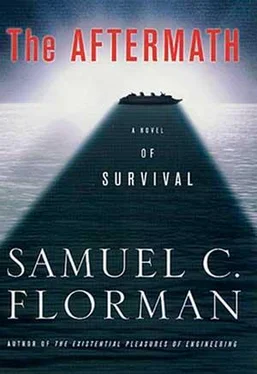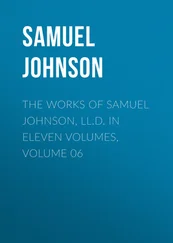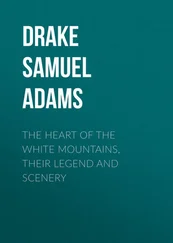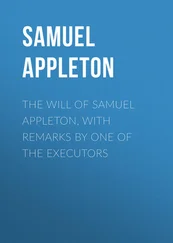Samuel Florman - The Aftermath
Здесь есть возможность читать онлайн «Samuel Florman - The Aftermath» весь текст электронной книги совершенно бесплатно (целиком полную версию без сокращений). В некоторых случаях можно слушать аудио, скачать через торрент в формате fb2 и присутствует краткое содержание. Город: New York, Год выпуска: 2001, ISBN: 2001, Издательство: Thomas Dunne books, Жанр: sf_postapocalyptic, на английском языке. Описание произведения, (предисловие) а так же отзывы посетителей доступны на портале библиотеки ЛибКат.
- Название:The Aftermath
- Автор:
- Издательство:Thomas Dunne books
- Жанр:
- Год:2001
- Город:New York
- ISBN:0-312-26652-9
- Рейтинг книги:5 / 5. Голосов: 1
-
Избранное:Добавить в избранное
- Отзывы:
-
Ваша оценка:
- 100
- 1
- 2
- 3
- 4
- 5
The Aftermath: краткое содержание, описание и аннотация
Предлагаем к чтению аннотацию, описание, краткое содержание или предисловие (зависит от того, что написал сам автор книги «The Aftermath»). Если вы не нашли необходимую информацию о книге — напишите в комментариях, мы постараемся отыскать её.
The Aftermath — читать онлайн бесплатно полную книгу (весь текст) целиком
Ниже представлен текст книги, разбитый по страницам. Система сохранения места последней прочитанной страницы, позволяет с удобством читать онлайн бесплатно книгу «The Aftermath», без необходимости каждый раз заново искать на чём Вы остановились. Поставьте закладку, и сможете в любой момент перейти на страницу, на которой закончили чтение.
Интервал:
Закладка:
“Challenge is one thing, perpetual torment is another,” Sarah offered. “If I thought that heaven were deliberately cruel—which I do not, by the way—I fear I would echo the words of Dostoevsky’s Ivan Karamazov. After thinking about all the misery that exists, particularly the horrible anguish suffered by innocent children, Ivan says that he intends to ‘most respectfully’ return his ticket to God—that is, his ticket of admittance to the world.”
“Hey, gang,” I said, “this is the holiday season. Let’s lighten up. How about a little jingle bells and mistletoe?”
“You know,” Roxy said, “one of the things I’ve always liked best about Christmas is that it comes exactly a week before New Year’s. A week to plan how you’re going to party. I love New Year’s Eve. It doesn’t carry any of the emotional baggage of the other holidays. After Thanksgiving and Christmas, it’s just what’s needed. No matter where I’ve been in the world, and no matter whether things were looking up or down, I’ve always tried to celebrate the coming of January. Out with the fuddy-duddy old guy with the sickle, and in with the darling little baby. New beginning. New hope. Last year, we were in a state of shock, with nothing to be festive about. But this year I think we should live it up a little.”
“There are several parties being planned, you know,” Sarah said.
“Yes,” Tom said, “they’re ready to test one of the new steam engines at Empangeni, and the plan is to start it up at midnight of December 31 with toasts and music. I’ve been meaning to tell Mary that we’ve been invited.”
“We’re not going to any party at Empangeni,” Mary said. “I love steam engines. But if I have anything to say about it, we’re going to celebrate with our friends right here in Engineering Village. Herb and Roxy will be gone soon enough. I think we should be together.”
“I figured that’s the way you’d feel,” Tom said, just a touch sheepishly. “I’ve already told them I’d come over to see the engine the next morning.”
“What I’ve been thinking,” Roxy said, “is that this is the time for us to have another fling with our line dancing. I know we associate that with the carefree days before the Event, and we’ve never had the heart to go back to it. But I’ve been saving my cowgirl outfit, damn it, and I’m just dying to put it on again.”
“But how about the music?” Mary asked. “Without electricity, there’s no way we can play that boom box of yours.”
“I’m way ahead of you on that,” Roxy said. “A few of the guys from the band have agreed to help out. I’ve got them rehearsing ‘Cowboy Hustle,’ ‘Tennessee Stroll,’ ‘Country Strut,’ and my very best favorite, ‘Dallas Shuffle.’”
She started to hum and clap her hands. “You remember ‘Dallas Shuffle,’ don’t you? Come on, grab your partners. Just for a minute, just to see if you can still move.”
We rose to our feet, awkward and uncertain. The women were several months pregnant, and it showed. But then Sarah called out, “Let’s do it!” and there we were, modified sweetheart position, moving to the music. Roxy sang out the melody and continued to clap the rhythm, while at the same time she nudged Herb into position next to her. I tried to remember the old instructions: “Lift your stomach, rib cage up and in. Lift your chin so that it’s parallel to the floor. Don’t look down!” Pretty soon it was coming back. The body remembers. And there we were, stepping lively, feeling good, looking good, too—better still, not caring how we looked.
Thus do we answer the heavens. With dance. With steam engines. And with our babies to come.
After awhile, we sat down, out of breath, laughing—for the moment without a care. Or rather, with cares held at bay by Roxy’s dauntless spirit, and by our own. Suddenly, Sarah took my hand and placed it on her belly. I felt movement, as if the little feet within were trying to mark the beat.
AUTHOR’S NOTE
I began work on this book by searching for a place—a part of the world in which the survivors could, with some prospect of success, attempt to rebuild a technological society. It had to be a place endowed with temperate climate, flourishing agriculture, and large numbers of domestic animals. Other natural resources were a must—especially timber, coal, iron, and copper. Furthermore, these resources had to be close to an ocean shore and concentrated within an area that could serve as home for a functional community—say a circle with a diameter of a hundred miles or so. It was easier to describe such a spot than to find it.
A solution suggested itself one day when I pulled down from my bookshelf a copy of The Times Atlas and turned to Plate 1, “World Minerals.” My eye fell immediately on South Africa, where the map showed several large symbols indicating an abundance of crucial materials. Other charts in the atlas, dealing with crops, livestock, and climate, seemed also to support South Africa as a promising possibility.
However, South Africa is a large country, and the information in the atlas did not enable me to zero in on an area of the requisite limited size. My problem was solved when, through the good offices of Martin Creamer, Publishing Editor of Martin Creamer’s Engineering News, Gardenview, South Africa, I was able to retain as a researcher Dr. Kelvin Kemm, a consulting engineer from Pretoria. This professional contact blossomed into an E-mail friendship that I have come to value highly. My files now bulge with maps, charts, catalogues, technical papers, and lengthy letters dealing with South African natural resources—also such non-technical matters as Zulu names, childhood memories of Durban, stories about wild animals, etc.—much more than I could possibly use in a dozen books. Collecting the information became something of an end in itself, and as soon as the research project ended, I started to miss those lively messages from Pretoria. In addition to his valuable research, Kelvin read one draft of the manuscript and made some insightful suggestions. His cheerful enthusiasm for the enterprise was a great morale-booster.
The information I received from Kelvin Kemm convinced me that, from a geographical point of view, the province of KwaZulu Natal was the ideal setting for my story. Fortuitously, it turned out that the population of that region also met my criteria for an ideal supporting cast—multi-ethnic, technologically accomplished, and most of all, politically pragmatic.
Several other South African engineers provided support and information. In response to a letter of inquiry that Martin Creamer printed in his publication, I received friendly communiques from Bill Brunjes, Elma Holt, Wally Langsford, Philip Lloyd, and Patrick Taylor.
Once the sphere of action was established, my next task was to devise a means of destroying all the people on Earth outside of the chosen spot. With most catastrophes, such as earthquake, nuclear war, disease, and climate change, I found it exceedingly difficult to wipe out everyone in the world except for a select few in KwaZulu Natal. However, the impactor-from-space scenario showed promise, and this is the one I decided to pursue. Embarking on a journey around the Internet, I discovered a lively community of people interested in—and wary of—comets and asteroids. Eventually I found my way to the Lunar and Planetary Laboratory at the University of Arizona. More particularly, I made contact with James Head, a graduate student in the university’s Department of Planetary Sciences. Calculations for the calamity scenario are his. If there are purists who are not convinced by the figures, let me just say that destruction of the world is not a field in which there has ever been much by way of agreed standards. In general, the K/T disaster theory has gained wide support, and Walter Alvarez has provided a simplified exposition of it in his book, T. Rex and the Crater of Doom. A more scientific treatment is “Ignition of Global Wildfires at the Cretaceous/Tertiary Boundary,” by H. J. Melosh and N. M. Schneider of the Lunar and Planetary Laboratory, K. J. Zahnie of NASA, and D. Latham of the U.S. Forest Service Intermountain Fire Sciences Laboratory, Nature, 18 January 1990. In that paper there is reference to F. L. Whipple’s hypothesis about the rain-down of fire through “molecular drag,” Proceedings of the National Academy of Sciences, 1950.
Читать дальшеИнтервал:
Закладка:
Похожие книги на «The Aftermath»
Представляем Вашему вниманию похожие книги на «The Aftermath» списком для выбора. Мы отобрали схожую по названию и смыслу литературу в надежде предоставить читателям больше вариантов отыскать новые, интересные, ещё непрочитанные произведения.
Обсуждение, отзывы о книге «The Aftermath» и просто собственные мнения читателей. Оставьте ваши комментарии, напишите, что Вы думаете о произведении, его смысле или главных героях. Укажите что конкретно понравилось, а что нет, и почему Вы так считаете.












